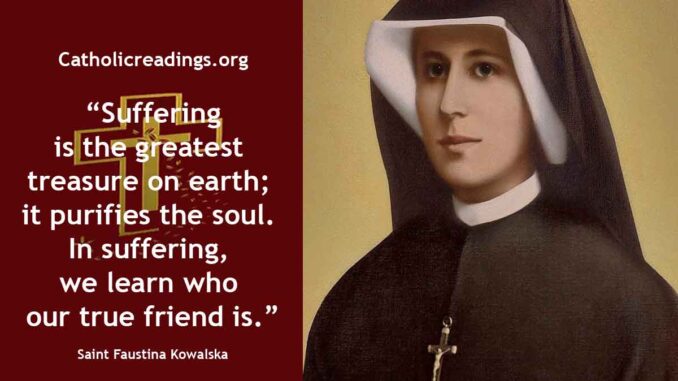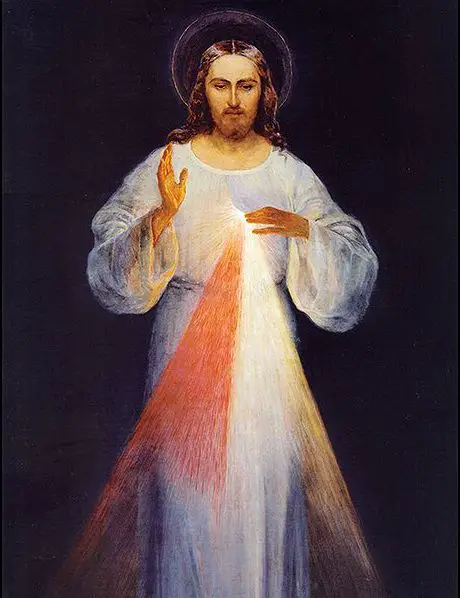St Maria Faustina Kowalska was also known as Helena Kowalska or Mary Faustyna of the Blessed Sacrament.
She was a Polish Roman Catholic nun and mystic through whom the Lord Jesus communicated to the world the great message of God’s Divine Mercy.
She was born on August 25 1905 in Głogowiec, Łęczyca County in Poland and died on October 5 1938 at the age of 33 in Kraków, Poland.
Her feast day is celebrated on October 5 every year in the Catholic Church.
| St Faustina Kowalska Biography | |
|---|---|
 |
|
| Date of Birth | August 25 1905 |
| Place of Birth | Głogowiec, Łęczyca County in Poland |
| Profession | Polish Roman Catholic nun |
| Place of Work | Poland |
| Date of Death | October 5 1938 |
| Place of Death | Kraków, Poland |
| Feast Day | October 5 |
| Beatification | By Pope John Paul II on April 18 1993 at St Peter’s Square, Vatican City |
| Canonization | By Pope John Paul II on April 30 2000 at St Peter’s Square, Vatican City |
| Patron Saint of | Apostle of Divine Mercy |
St Faustina Kowalska Life History
St Faustina Kowalska’s father was called Stanisław Kowalski, a poor peasant farmer and a carpenter, and her mother was called Marianna Kowalska. She was the third born in a family of ten children.
At the age of seven, Faustina Kowalska attended the Exposition of the Blessed Sacrament and felt her first call to religious life.
After she completed her basic education, she wanted to join the convent but her parents denied her permission.
Faustina Kowalska started working as a housekeeper at the age of 16 in Aleksandrów Łódzki near Lodz in order to earn a living for herself and her poor parents too. While working here, she received the Sacrament of Confirmation.
In 1924, when she was 19 years old, Faustina Kowalska with her sister Natalia went out to a party. As she was dancing, she had a vision of Jesus Christ asking her, ‘How long shall I tolerate you, and for how long will you keep avoiding Me?”
Jesus Christ instructed Faustina Kowalska to leave for Warsaw immediately and enter a convent. She left and managed to carry only the dress that she was wearing.
She traveled by train and upon reaching Warsaw, she went straight to the first Catholic Church she saw. She did this without her parent’s permission and without knowing anybody in Warsaw.
The Catholic Church she went to was the Church of the Immaculate Conception of the Blessed Virgin Mary in Grójecka Street in the Ochota district of Warsaw.
Here she was received by Father Dąbrowski who suggested that she stays with a trustworthy woman called Mrs. Lipszycowa until she found a convent.
Faustina Kowalska went to several convents to seek admission but was rejected. Because of her poverty, she was rejected in one convent where she was dismissed with the words, “We do not accept maids here.”
Luckily, she stumbled upon the convent of the Congregation of the Sisters of Our Lady of Mercy where the Mother Superior accepted Faustina Kowalska under one condition, that she would pay for her stay there.
From 1925, she worked there as a housemaid and remitted her earnings to the convent, and finally, the Mother Superior officially admitted her at the convent.
The following year, on April 30 1926 at the age of 20 years, Faustina Kowalska received the religious name, Sister Maria Faustina of the Blessed Sacrament, and was clothed in the habit.
In April 1928, she completed her novitiate and in the presence of her parents, she took her first religious vows as a nun.
She was posted as a cook to the convent in Wilno (now known as Vilnius, the capital of Lithuania) for almost three months, from February to April 1929. Thereafter, she was posted to the convent in Płock, Poland.
While in Płock in May 1930, the first signs of her illness started to manifest. It was initially thought to be the deadly tuberculosis but she recovered.
On Sunday, February 22 1931 at night in her cell, Jesus appeared to her wearing a white garment, and from His heart emanated red and pale rays. One of His hands was raised in blessing, while the other was touching the garment at the breast.
Jesus told her, “Paint an image according to the pattern you see, with the inscription: Jesus, I trust in You.” Jesus also told her that He desired that the image be venerated throughout the world, beginning with their chapel, and that the souls that will venerate this image will not perish.
He also said that the image should be solemnly blessed on the first Sunday after Easter Sunday which would become the Divine Mercy Sunday.
Faustina Kowalska did not know how to paint, she asked for help from other nuns at the Płock convent but found none. This image would be produced in Vilnius, three years later.
On May 1 1933, Faustina Kowalska took her final vows as a nun in Łagiewniki, Kraków, Poland, and became in perpetuity a sister of Our Lady of Mercy.
Faustina Kowalska was transferred back to Vilnius to work as a gardener in May 1933. Here she met Fr. Michael Sopoćko who was the confessor to the nuns and a pastoral theology professor at Stefan Batory University (now Vilnius University).
Faustina Kowalska, during confession, told Fr. Michael Sopoćko that she had been conversing with Jesus Christ. Fr. Michael Sopoćko was hesitant to believe and insisted that she be psychiatrically evaluated.
She was evaluated by a psychiatrist and a physician called Helena Maciejewska. Faustina Kowalska passed all the required tests and was declared of sound mind and disposition.
From that time, Fr. Michael Sopoćko started believing in what she was saying and began to support her efforts. He encouraged her to write in her diary all the messages and conversations she had received from Jesus.
Fr. Sopoćko introduced her to an artist called Eugene Kazimierowski who by June 1934, produced the Divine Mercy image the way she instructed.

Kowalska says that on Good Friday, April 19 1935, Jesus told her that the Divine Mercy image to be publicly honoured, and on April 26 1935, Fr. Sopoćko delivered the first sermon about the Divine Mercy, and on April 28 1935 on the second Sunday of Easter, the Divine Mercy image was publicly displayed.
Kowalska also obtained permission from Archbishop Romuald Jałbrzykowski to display the Divine Mercy image in Our Lady of the Gate of Dawn Church in Vilnius when he celebrated the Mass there himself.
Faustina Kowalska, on September 13 1935 had a vision about the Chaplet of Divine Mercy whose purpose is to obtain mercy, to trust in Christ’s mercy, and to show mercy to others.
In November 1935, Kowalska contemplated leaving her Order to start her own congregation that was devoted to Divine Mercy but she was reminded that she had taken the vows to perpetually remain in her current Order.
She was transferred to another convent in Warsaw where Jesus Christ told her, “My Daughter, do whatever is within your power to spread devotion to My Divine Mercy, I will make up for what you lack.”
Fr. Sopoćko wrote the first brochure on the devotion of Divine Mercy in 1936, and Archbishop Romuald Jałbrzykowski gave permission for it to be printed. Fr. Sopoćko became the main promoter of the devotion to Divine Mercy.
In 1936, Faustina Kowalska became ill again and was moved to Prądnik, Kraków to convalesce. She spent the rest of her two years in life writing her diary, praying the Divine Mercy Chaplet for the conversion of sinners.
Faustina Kowalska had written in her diary on March 23 1937, that she had a vision that the feast of the Divine Mercy would be celebrated in her local Church and also in Rome by the Pope.
Kowalska together with Fr. Sopoćko wrote the instructions for the Novena of Divine Mercy and in 1937 a pamphlet with the title Christ, King of Mercy was published.
The contents of the pamphlet were: The Divine Mercy image appeared on the cover, the novena and the litany of the Divine Mercy, and the signature “Jesus I Trust in You”.
Faustina Kowalska, before her death, had predicted that there would be a very big and terrible war and therefore told the nuns to pray for Poland.
After the war broke, Archbishop Romuald Jałbrzykowski noticed that the predictions were true. He allowed the public to access the Divine Mercy image and huge crowds turned up and found strength and inspiration.
This led to the spread of the Divine Mercy devotion to the rest of Poland, the United States, and worldwide.
After the war, Fr. Sopoćko helped the formation of the Congregation of the Sisters of the Divine Mercy. By 1951, there were 150 Divine Mercy centers in Poland.
St Faustina Kowalska Death
Faustina Kowalska’s health deteriorated fast and in April 1938 she was taken back home to Kraków to await her death there.
She died October 5 1938 at the age of 33 in Kraków, Poland, and was buried at Kraków’s Basilica of Divine Mercy.
Saint Faustina Kowalska Miracle
The miracle that gave way to Faustina’s beatification involved the healing of Maureen Digan of Massachusetts.
Maureen Digan had been healed from lymphedema. Her leg had the condition of retaining fluid and swelling. The other leg had been amputated.
She went to Poland and as she was praying at Faustina Kowalska’s tomb, a voice told her “Ask for my help and I will help you.”
Her constant pain stopped and her foot was healed. When she returned to the United States, the doctors there declared that she was healed.
Beatification
By Pope John Paul II on April 18 1993 at St Peter’s Square, Vatican City
Canonization
By Pope John Paul II on April 30 2000 at St Peter’s Square, Vatican City
St Faustina Kowalska Feast Day
Her feast day is celebrated on October 5 every year in the Catholic Church. On May 18 2020, Pope Francis added Saint Faustina Kowalska to the General Roman Calendar as an optional memorial.
Other Catholic Saints whose Feast Days are in October
Related Links
Powered By SEO Experts
Follow @ReadingCatholic
